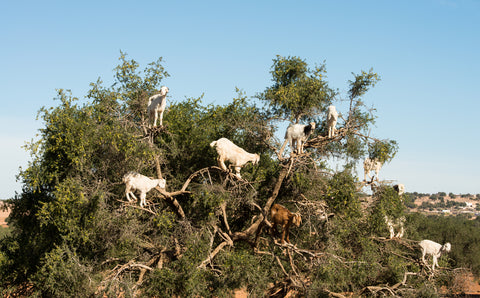The True Story of Argan Oil

Ingredients are always on top of our mind. We are big proponents of educating consumers on how to read and understand skin care product labels. We also love talking about nourishing, enriching, and good-for-you ingredients that we use in our product formulations.
One ingredient that we absolutely adore is organic Argan Oil, also known as "Moroccan Gold." And while it doesn’t get as much publicity as healthy ingredient poster child Coconut Oil, it has a history that you won’t forget!
Argan Oil is like the truffle oil of the food world. It is rare in terms of its availability, expensive, and once required the help from a 4-legged creature to deliver it to you. Unlike pigs that riffle through the forest for truffles, goats are the animal of choice for Argan Oil.
Argan oil comes from the nut of a black olive-like fruit from the Argan Tree that is extremely rare, only growing in southwestern Morocco (other countries have tried to grow it but have failed). At one point it was almost deemed extinct, but because demand for the oil increased (it's a revered ingredient in hair care, skin care, and even cooking), programs were created to protect and preserve the species.
The process of extracting oil from the nut, or seed, is made arduous by the tough, bullet-proof shell surrounding the nut. Enter goats: the always hungry, grazing animals have a taste for the Argan fruit, even climbing to great heights to eat a meal. However, they do not like the nut. They will either spit it out or, but if they don't, it will naturally come out the other end (if you get out our drift). This helps soften the shell, which significantly aids in the extraction and production process.
Now there are more acceptable (and, well, less fun!) means of extracting Argan Oil, but we appreciate the goats for all their hard work in helping to make Argan accessible so that we could one day put it in our Tinted Moisturizer and Carrot Facial Dream Cream. Packed full of Vitamins A and E it has powerful antioxidant properties to keep wrinkles at bay and cell-regenerating properties to speed up healing scars and minimize the appearance of stretch marks. It's tough for us to think it was once almost extinct.




Leave a comment